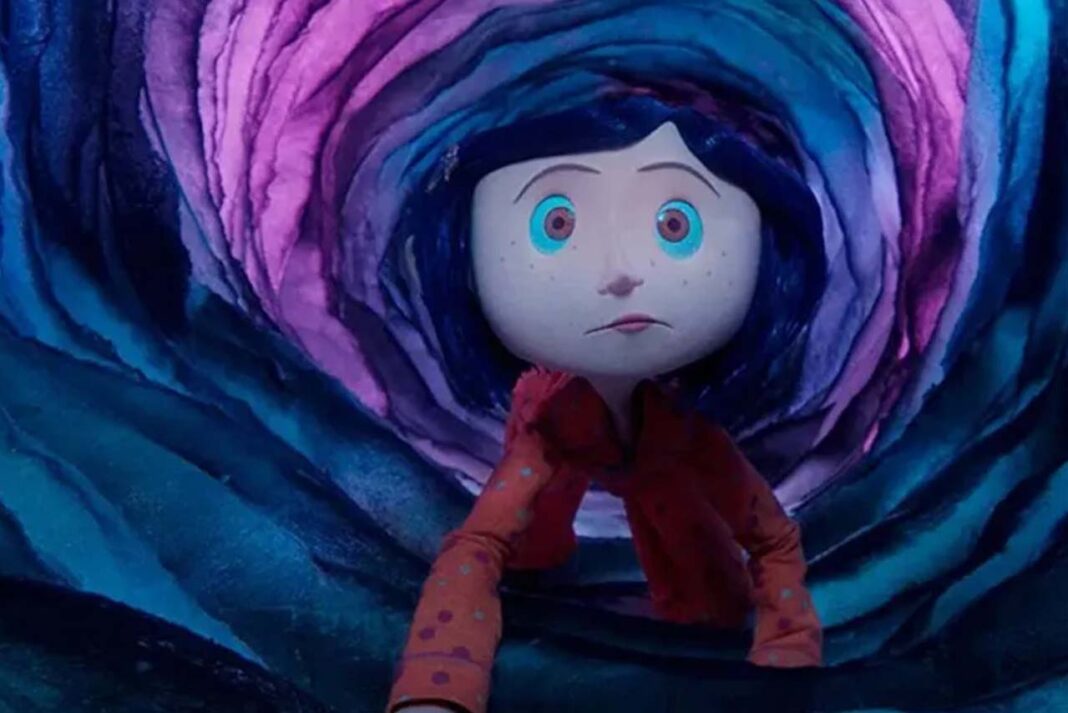Modern Family and Coraline’s Emotional Void
At first glance, Coraline (2009) appears to be a children’s animation, but it actually serves as a mirror to the modern family structure. The desire to be seen — the most fundamental emotional need of children — transforms into an identity conflict throughout the film.
Coraline grows up in a home where she is emotionally unseen. Her workaholic parents are absorbed in their own worlds and cannot devote time to her. They spend their days working, writing about gardening, yet they never touch the soil. This reflects the irony of the modern world — people no longer do what they love, but what they must.
Because of her parents’ indifference, Coraline feels unnoticed, creating a void within her inner world. Her deepening need to be noticed, loved, and valued becomes the foundation of her journey toward selfhood. Coraline’s curiosity and strong observational abilities amplify this desire, yet her parents remain blind to it.
The Other World and the Price of Being Seen
Coraline’s transformative journey begins when she discovers a secret door that leads to a parallel world. In this alternate reality, she meets her “other mother,” who, unlike her real mother, fulfills her every wish and showers her with affection and attention. For the first time, Coraline feels truly seen and loved.
However, in this world, nearly everyone’s eyes are replaced with buttons, except for her companion, the black cat, whose real eyes symbolize independent perception. The cat serves as a metaphorical guide, reminding Coraline of her own gaze and her capacity to perceive reality without external validation.
This enchanting world soon reveals its sinister side. The other mother offers Coraline the chance to stay forever — on the condition that she replaces her eyes with buttons. The promise of eternal visibility comes at the cost of her autonomy and freedom. By refusing, Coraline begins her journey of subjectification, asserting her independence from the gaze of the other.
Lacanian Perspective
According to Jacques Lacan, the individual cannot construct identity in isolation; the self is always formed through the gaze of the Other. In Lacan’s mirror stage, the child experiences an illusion of wholeness by identifying with its reflection, yet this sense of completeness is externally derived — a fantasy of unity rather than genuine self-integration.
Coraline never experiences this process fully in her real life. Her parents’ emotional absence leaves her unseen, preventing the formation of a stable identity. In the other world, the “other mother” temporarily fulfills this lack, recreating the illusion of wholeness. However, this visibility is conditional — Coraline’s self becomes shaped by the desire of the Other, leading to submission rather than liberation.
When Coraline refuses to have buttons sewn onto her eyes, she breaks the illusion of externally defined selfhood. This moment signifies her symbolic separation from the Other’s gaze — a rejection of dependence. For Lacan, the subject becomes truly autonomous only when it resists the desire of the Other. Coraline’s act of defiance marks her first step toward authentic subjectivity.
Freudian Perspective
From Sigmund Freud’s psychoanalytic viewpoint, Coraline’s conflict can be understood as stemming from unmet narcissistic needs and a resulting search for validation.
In early development, a child requires unconditional love and recognition to establish self-worth. When these needs go unmet, a narcissistic injury occurs — an emotional wound that drives the individual to seek compensation through symbolic or external means.
Coraline’s parents, confined by modern life’s demands, offer conditional affection, responding only when she meets expectations. Her repeated attempts to gain their attention reflect her narcissistic deprivation. In the other world, the “other mother” provides an illusion of perfect, unconditional love, leading Coraline to invest her emotional energy into this idealized figure — a process Freud calls libidinal cathexis.
However, this attachment transforms into identification in love — Coraline tries to embody what the other mother desires in order to preserve her affection. Consequently, her self becomes entangled in the Other’s desire, mirroring Lacan’s concept of subjectivity under the influence of external gaze.
Resolution and Subject Formation
Coraline’s psychological transformation occurs at the intersection of Lacanian and Freudian theories.
Following Freud, she develops an internal value system — moving away from dependence on external approval and toward an autonomous sense of self (Ichideal). Simultaneously, in Lacanian terms, she rejects subjugation to the desire of the Other.
By the film’s conclusion, even though Coraline’s parents remain partially detached, she no longer defines her identity through their recognition. She has claimed her subjectivity, realizing that being seen is not the prerequisite for existence.
True subjectification, both in Coraline’s world and in psychoanalytic theory, occurs when one frees the self from the gaze and desire of others, affirming a self-defined sense of being.
References
-
Freud, S. (2013). Narcissism: An Introduction to the Study of Self and Object Relations. İstanbul: Metis Publishing.
-
Lacan, J. (2006). The Mirror Stage and the Theory of the Subject. İstanbul: Sel Publishing.


